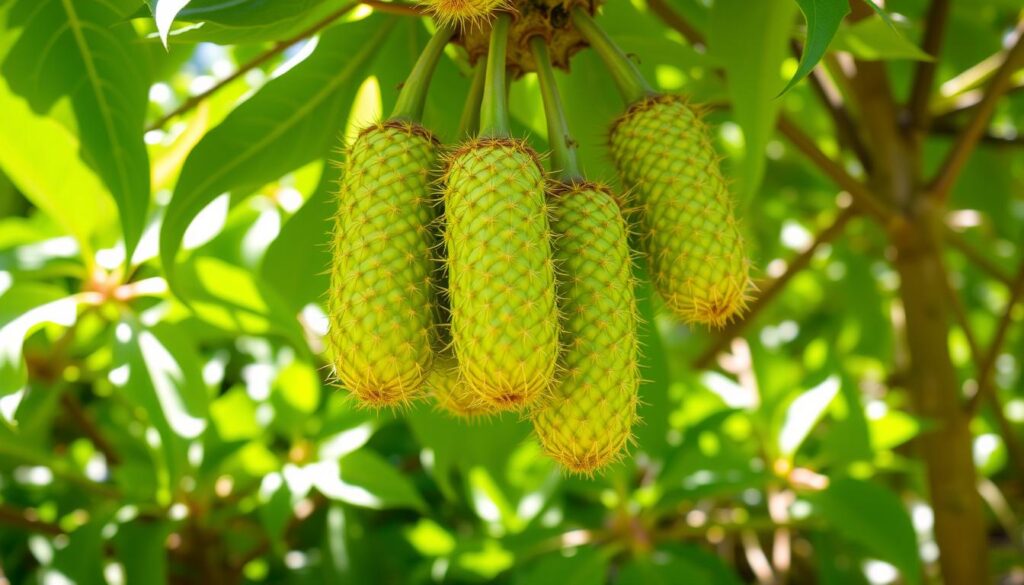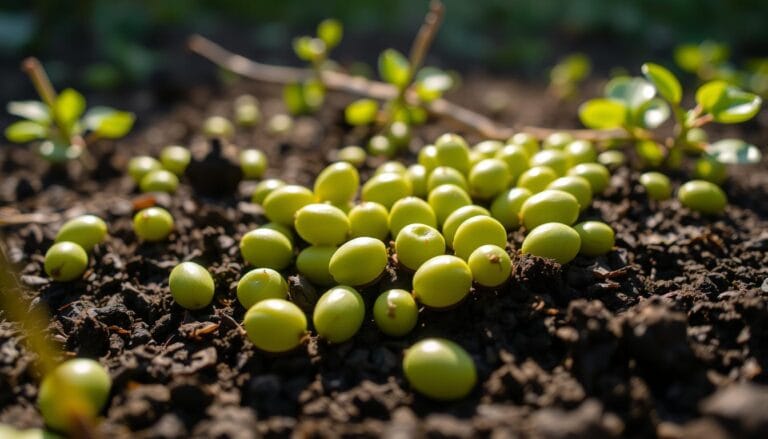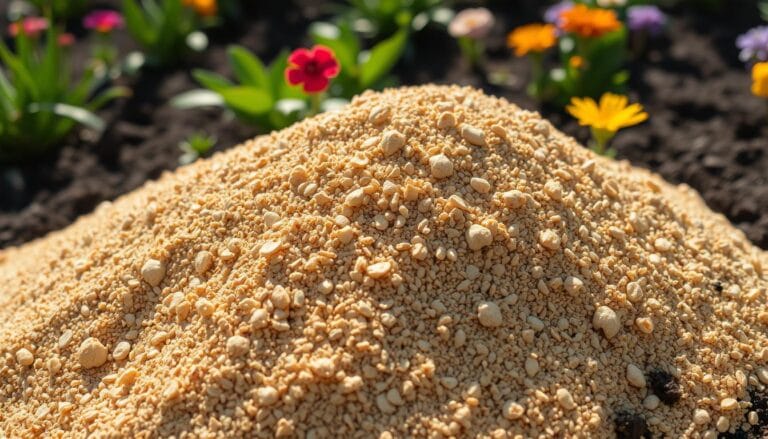Prickly Green Pods: Fascinating Plants to Discover in 2025

Have you seen plants with prickly green pods in your garden or outdoors? These plants have developed prickly green pods as a defense. As you learn more, you’ll find out about the different types and their features.
Exploring plants with prickly green pods reveals their many benefits. They are useful in cooking and offer nutritional value. Their unique look and uses make them interesting to study further.
Table of Contents
Understanding Prickly Green Pods in Nature
As you explore the natural world, you might see plants with prickly green pods. The prickly pear cactus is a good example. These plants have special features to survive in tough places. Their spines and waxy coatings help protect them from harm and save water.
These traits help these plants live longer in dry areas. Many of these plants live in the deserts of the Americas. The prickly pear cactus is very common there.
Natural Defense Mechanisms
Some key ways these plants defend themselves include:
- Spines that keep predators away
- Waxy coatings that stop water from escaping
- Deep roots for storing water
Evolutionary Advantages
These traits offer many benefits, such as:
- Living longer in dry places
- Being better at getting what they need from the environment
- Being stronger against diseases and pests
Geographic Distribution
Plants with prickly green pods can be found in different places. Many species live in:
| Region | Common Species |
|---|---|
| Deserts of the Americas | Prickly pear cactus |
| African savannas | Various succulent species |
Common Varieties of Pod-Bearing Plants
Exploring plants with prickly green pods opens up a world of desert plant species. These plants have adapted to survive in dry, harsh conditions. They have evolved special features to save water and protect themselves from extreme desert temperatures.
Some famous desert plant species are the prickly pear cactus, the cholla cactus, and the ocotillo plant. These plants have unique roots, stems, and leaves to live in the desert. Their prickly green pods help protect them from predators.
Here are a few examples of desert plant species with interesting traits:
- Prickly pear cactus: known for its edible fruits and vibrant flowers
- Cholla cactus: recognized by its dense, branching stems and sharp spines
- Ocotillo plant: identifiable by its clusters of red flowers and delicate, lacy foliage
These desert plant species not only beautify the desert but also keep the ecosystem balanced. By learning about and valuing these plants, we can develop a deeper respect for nature and the wide variety of life on Earth.
The Fascinating World of Prickly Pear Cactus
The prickly pear cactus is unique and has many uses. It has over 200 species and is a striking plant. It’s found in many places, especially in the Americas, where it’s been used in food for centuries.
The cactus is very versatile. Its fruits, called tunas, are tasty and can be eaten raw or used in desserts. The pads, or nopales, can be grilled, sautéed, or added to salads. This shows how the cactus can be used in many ways.
Different Species Types
Some prickly pear cactus species are better for food than others. For example, Opuntia ficus-indica is grown for its fruits and pads. Knowing about different species helps you use the cactus in your cooking.
Growing Seasons
The growing seasons for prickly pear cactus depend on the species and climate. It likes warm, dry places, making it perfect for areas with little rain. Knowing when and where to grow it helps you enjoy its culinary benefits.
Growing Your Own Pod-Bearing Plants
To grow your own pod-bearing plants, you need to think about a few important things. First, pick a soil that drains well and is full of nutrients. This will help your plants grow strong and give you lots of green pods. Next, make sure they get the right amount of water and sunlight. Most plants need full sun to partial shade and moderate watering.
For pest control, it’s best to use natural methods. This keeps the environment safe and your plants healthy. Some good ways include:
- Using neem oil to repel pests
- Introducing beneficial insects to your garden
- Practicing good garden hygiene to prevent infestations
By following these tips and taking a balanced approach to gardening, you can enjoy the benefits of healthy eating. As you care for your plants, you’ll get a lot of nutritious and tasty pods.
Cultivating your own pod-bearing plants is a rewarding experience. It lets you connect with nature and enjoy the benefits of healthy eating. With the right care, you can grow a garden that gives you fresh, nutritious pods.
| Plant Type | Soil Requirements | Watering Needs |
|---|---|---|
| Prickly Pear Cactus | Well-draining soil with moderate nutrients | Moderate watering, allowing soil to dry between waterings |
| Other Pod-Bearing Plants | Rich, nutrient-dense soil with good drainage | Regular watering, with occasional fertilization |
Essential Safety Tips for Handling Prickly Green Pods
Working with plants with prickly green pods requires safety first. You must handle them carefully to avoid injuries. It’s important to wear protective gear and learn how to cook them safely.
Protective Equipment
Wear long sleeves, gloves, and eye protection when handling these plants. This gear prevents injuries from spines and glochids. Also, use a mask to avoid inhaling spines or glochids.
Cleaning Methods
Cleaning the pods is key before eating them. Use tongs or a fork to hold the pod. Then, remove spines and glochids with a knife or vegetable peeler.
After cleaning, wash the pods well with water. This removes any leftover spines or glochids. Once ready, you can cook the nopales in many ways. Try sautéing them with garlic and onions, or add them to soups and salads. Just remember to remove the spines and glochids before cooking.
Culinary Applications and Preparation Methods
Exploring plants with prickly green pods opens up a world of vegetable recipes. These plants are a nutritious superfood that can be used in many dishes. They add unique flavors and textures to salads and entrees.
Popular ways to prepare these plants include grilling, sautéing, and pickling. Here are some ideas:
- Nopales salads, which combine the tender pads of the cactus with onions, garlic, and chili peppers
- Grilled cactus pads, which can be served as a side dish or used as a topping for tacos and other Mexican dishes
- Pickled cactus, which adds a tangy, sour flavor to a variety of recipes
It’s important to handle these plants safely and prepare them properly. This way, you can enjoy their culinary benefits. You’ll experience their unique flavors and textures in vegetable recipes.
As a nutritious superfood, these plants are great for a healthy diet. They provide vitamins, minerals, and antioxidants. Adding them to your meals can make them more exciting and open up new culinary possibilities.
Nutritional Benefits and Health Properties
Incorporating a nutritious superfood into your diet can greatly improve your health. Plants with prickly green pods, like cacti, are a great choice. They are packed with vitamins, minerals, and antioxidants, making them perfect for a healthy diet.
These plants are full of vitamins A and C, and minerals like calcium and iron. They also have lots of antioxidants. These help protect cells and lower disease risks. Adding them to your meals can boost your health and well-being.
Vitamin Content
Plants with prickly green pods are rich in vitamins A and C. These vitamins are key for a strong immune system and healthy skin. They also help fight off common illnesses like the cold and flu.
Mineral Composition
These plants are also packed with minerals like calcium and iron. Calcium is vital for strong bones, and iron helps make healthy red blood cells. Including them in your meals is crucial for a balanced diet.
Antioxidant Properties
The antioxidant properties of these plants are impressive. Antioxidants protect cells and lower disease risks. By eating these plants, you support healthy eating and improve your health.
Sustainable Harvesting Practices
Exploring desert plant species, like the prickly pear cactus, highlights the need for sustainable harvesting. It’s key to protect these plants and their habitats for the future.
Harvesting desert plants should be done carefully to avoid harming them or their environment. It’s important to only harvest what you need and leave enough for the plants to regrow. Also, always follow local regulations and guidelines for harvesting.
Some important tips for sustainable harvesting include:
- Only harvest mature plants that are ready
- Use the right techniques to avoid damaging the plants or their roots
- Leave some plants to regrow and reproduce
By using sustainable harvesting, you help protect desert plants, like the prickly pear cactus. This ensures they are available for future generations.
Environmental Impact
Over-harvesting can harm the environment a lot. It can damage habitats and reduce biodiversity. Sustainable harvesting helps protect desert ecosystems and their balance.
Conservation Methods
Methods like propagation and cultivation are also important for conservation. Growing these plants in controlled settings can reduce the need for wild harvesting. This helps conserve these unique species.
Common Mistakes to Avoid When Growing Pod Plants
When growing plants with prickly green pods, it’s key to know common mistakes. One big error is wrong watering, which can cause root rot. To fix this, water your plants carefully. Let the soil dry a bit before watering again.
Another mistake is not enough sunlight. Plants with prickly green pods, like those that grow edible cactus fruit, need lots of sun. Place your plants where they get enough sun but also stay cool.

- Over-fertilizing, which can damage the roots and leaves
- Not providing enough support for the plants as they grow
- Not monitoring for pests and diseases, which can quickly spread and harm the plants
Knowing these mistakes and avoiding them can help you grow plants with prickly green pods. You’ll enjoy their tasty edible cactus fruit.
With proper care and attention, plants with prickly green pods can thrive. They provide a lot of edible cactus fruit. They’re a great choice for any garden or landscape.
Conclusion: Embracing the Potential of Prickly Pod Plants
The world of plants with prickly green pods is both fascinating and diverse. From the versatile prickly pear cactus to other species, they offer many benefits. These plants are great for food, health, and the environment.
By embracing these plants, you can enjoy their tasty and nutritious qualities. You also help in sustainable harvesting. This preserves these important parts of our ecosystems.
Whether you grow your own prickly pod plants or just eat them, it’s all about exploration. Understanding their unique traits and role in nature opens up new culinary adventures. It also supports the conservation of these resilient species.
FAQ
What are plants with prickly green pods?
Plants with prickly green pods are desert plants like the prickly pear cactus. They have spines or tiny barbed bristles to protect themselves. These features help them save water in dry places.
What are the natural defense mechanisms of these plants?
The spines and pods of these plants keep them safe from animals. They also help keep moisture in during dry times. This helps the plants live well in the desert.
What are some common varieties of pod-bearing plants?
You’ll find many types of pod-bearing plants in the desert. These include different prickly pear cacti and cholla cacti. They all have unique spines and pods to survive in the desert.
What makes the prickly pear cactus unique?
The prickly pear cactus is well-known and very useful. It comes in many types and grows best in certain seasons. People use its fruits and pads in cooking.
How can I grow my own pod-bearing plants?
To grow these plants, choose the right soil and water them correctly. Also, protect them from pests. Growing them yourself lets you enjoy their health benefits and add them to your diet.
What safety precautions should I take when handling prickly green pods?
Always wear gloves when handling these plants. Use careful cleaning to remove spines and tiny bristles. Proper storage helps avoid accidents and makes cooking safer.
How can I use plants with prickly green pods in my cooking?
You can use these plants in many vegetable dishes. Try making salads with nopales or get creative with new recipes. They add a unique taste and are good for you.
What are the health benefits of plants with prickly green pods?
These plants are full of vitamins, minerals, and antioxidants. Eating them supports a healthy diet and overall health. They are considered a superfood.
How can I harvest these plants sustainably?
Harvesting these plants the right way is key. Follow conservation methods to protect them. This way, we can enjoy them for years to come.
What are some common mistakes to avoid when growing pod plants?
Don’t water them too much or not enough. Make sure they get enough sunlight. Also, handle the fruit carefully. Knowing these tips helps you grow and enjoy these plants.






